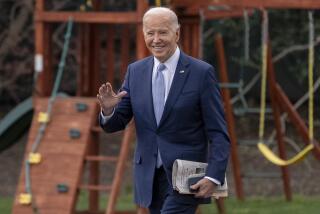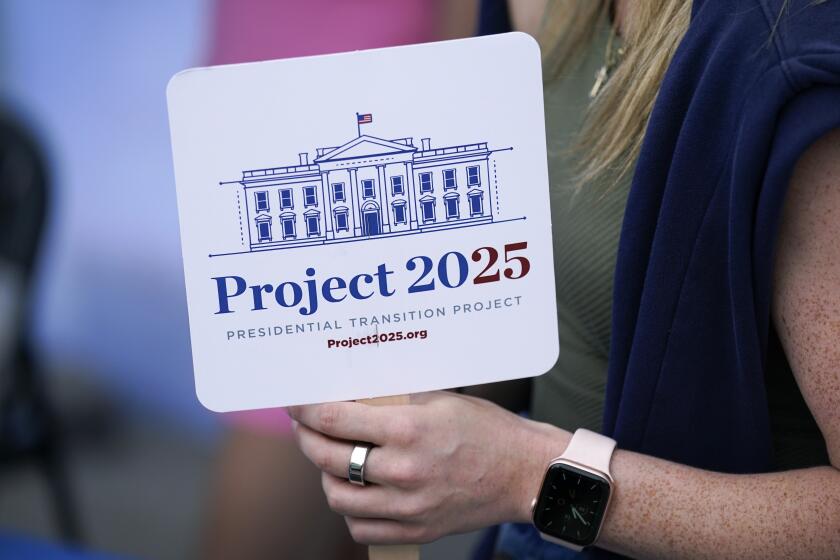Here’s where taxpayer money will go from the coronavirus package Trump just signed
- Share via
WASHINGTON — President Trump has signed a bipartisan $8.3-billion aid package aimed at developing a vaccine for the coronavirus and helping states deal with the spread of the disease.
Congress approved the emergency spending bill earlier this week, which is multiple times the $2.5 billion the Trump administration had requested initially and slightly less than the $8.5 billion Senate Minority Leader Charles E. Schumer (D-N.Y.) had proposed as a counteroffer.
“I asked for $2.5 [billion] and I got $8.3 [billion],” Trump told reporters shortly after signing it. “I’ll take it.”
Here’s a look at where that money will go:
First, what exactly did Congress pass and sign?
The spending bill was expedited and passed by both the House and Senate with huge bipartisan support in just two days, an unusual show of unity due to a public health crisis. Sen. Rand Paul (R-Ky.), Rep. Ken Buck (R-Colo.) and Rep. Andy Biggs (R-Ariz.) were the only members of Congress to vote against the emergency supplemental spending bill.
The bill is called a supplemental because it was passed outside the normal spending process.
Democrats demanded that the bill include restrictions to keep Trump from using the money for other things, such as building a wall at the southern border, and it states that the funds could be used only to combat the spread of the new coronavirus and other infectious diseases.
They also insisted on language to help ensure that the treatment or vaccine created with the help of taxpayer money can be purchased by the government at a “fair and reasonable price,” and instructs the secretary of Health and Human Services to make sure they will be affordable and accessible on the private market.
Where does the virus money go?
The bulk of the funds, $6.5 billion, goes to the Department of Health and Human Services for vaccine research or supporting state and local government response.
Of that, $2.2 billion is designated specifically for the Centers for Disease Control and Prevention. Within that, there’s $950 million for state and local response, including lab testing and tracing the contacts of infected people. Half of that money must be allocated within 30 days.
It also instructs the CDC to reimburse states and local governments for the cost of responding to the coronavirus, or their preparations to do so, since January.
The $6.5 billion for the HHS also includes more than $3 billion for research and development of vaccines and diagnostics to prevent or treat the new coronavirus, and $1 billion to buy pharmaceuticals and medical supplies like masks and protective equipment to send to hospitals and clinics. Some of that money will also go toward training medical staff and first responders on how to keep from getting sick themselves.
Where does the rest go?
The emergency supplemental also includes roughly $500 million to allow Medicare providers to use expand the use of “telehealth” services so that elderly patients, who are at greater risk from the virus, can receive care at home. Normally an elderly patient must live in a rural area to receive care through telehealth, a system that allows patients to receive healthcare or speak to a doctor via phone or internet rather than in person.
More than $1 billion will be sent overseas for evacuating embassy personnel, and humanitarian and economic aid to prevent the spread in other countries.
The package also includes $1 billion in new subsidies for the Small Business Administration to provide to small businesses, farmers and nonprofits financially affected by the outbreak.
The bill also reimburses hundreds of millions of dollars that the administration had already transferred from other programs in HHS.
What was left out?
The bill doesn’t address some of the broad societal changes that advocates have argued are necessary to stem the spread of the coronavirus, like expanded access to healthcare.
With the federal government scrambling to provide widespread access to test kits, people feeling ill are being encouraged to stay home for up to two weeks to keep the virus from spreading, something low wage or hourly workers without paid time off will struggle with, Sen. Patty Murray (D-Wash.) told reporters this week.
“Imagine if you are a low-income worker or your boss says you can’t stay home. People want to be safe and protected. They do not want to spread this. They want to take care of themselves. But we don’t have the capability right now to do it with the policies we have in place,” she said.
On Friday, Murray and Rep. Rosa DeLauro (D-Conn.) filed legislation to require employers to provide workers with 14 days of paid sick leave to be used during a public health emergency, including the current coronavirus outbreak. It is unlikely to pass in an election year.
More to Read
Get the L.A. Times Politics newsletter
Deeply reported insights into legislation, politics and policy from Sacramento, Washington and beyond. In your inbox twice per week.
You may occasionally receive promotional content from the Los Angeles Times.











